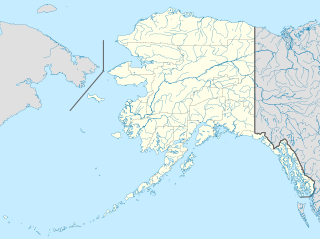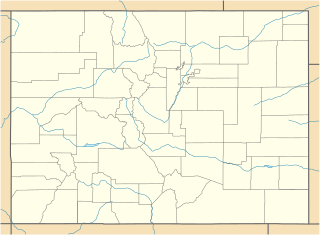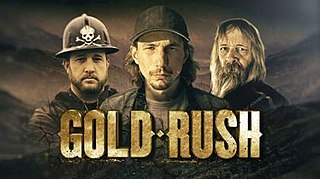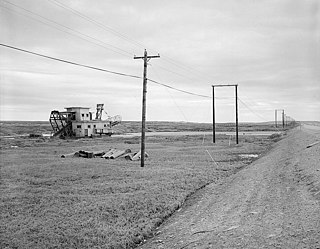 W
WGold mining in the United States has taken place continually since the discovery of gold at the Reed farm in North Carolina in 1799. The first documented occurrence of gold was in Virginia in 1782. Some minor gold production took place in North Carolina as early as 1793, but created no excitement. The discovery on the Reed farm in 1799 which was identified as gold in 1802 and subsequently mined marked the first commercial production.
 W
WBannack is a ghost town in Beaverhead County, Montana, United States, located on Grasshopper Creek, approximately 11 miles (18 km) upstream from where Grasshopper Creek joins with the Beaverhead River south of Dillon. Founded in 1862, the town is a National Historic Landmark managed by the state of Montana as Bannack State Park.
 W
WThe F.E. Company Dredge No. 4, also known as the Pedro Dredge and the Chicken Dredge, was originally owned by the Fairbanks Exploration Company, a subsidiary of the United States Smelting Refining & Mining Co. (USSR&M). It was built by the Yuba Manufacturing Company in California, and was shipped to Pedro Creek north of Fairbanks, Alaska in 1938. It was assembled there, and operated until 1958.
 W
WThe Fairbanks Exploration Company Gold Dredge No. 5 was a historic gold mining dredge in a remote area of Fairbanks North Star Borough, Alaska, north of the city of Fairbanks. It was last located on Upper Dome Creek, shortly northeast of the mouth of Seattle Creek, about 20 miles (32 km) north of Fairbanks, prior to its being scrapped c. 2012. The dredge was manufactured by the Bethlehem Steel Company in 1928, shipped in pieces to Alaska, and assembled by the Fairbanks Exploration Company on Cleary Creek, where it was used until 1942. It thereafter served on Eldorado Creek (1947–55) and Dome Creek (1955-59) before it was abandoned.
 W
WThe Gold Country is a historic region in the northern portion of the U.S. state of California, that is primarily on the western slope of the Sierra Nevada. It is famed for the mineral deposits and gold mines that attracted waves of immigrants, known as the 49ers, during the 1849 California Gold Rush.
 W
WGold mining in Colorado, a state of the United States, has been an industry since 1858. It also played a key role in the establishment of the state of Colorado.
 W
WGold Rush is a reality television series that airs on Discovery and its affiliates worldwide. The series follows the placer gold mining efforts of various family-run mining companies, mostly in the Klondike region of Dawson City, Yukon, Canada. In its 12th season as of early 2021, prior seasons also included mining efforts in South America and western North America.
 W
WGold Rush: White Water is a reality television series that airs on the Discovery Channel. A spin-off of Gold Rush, the series follows placer gold miners "Dakota" Fred Hurt and his son Dustin Hurt, returning to McKinley Creek in Haines Borough, Alaska, seeking their fortune by suction dredge diving within its raging waters.
 W
WHomestake Mining Company was one of the largest gold mining businesses in the United States and the owner of the Homestake Mine in Lead, South Dakota. Founded in 1877, it was acquired by Barrick Gold in December 2001.
 W
WThe Lost Nigger Gold Mine is a legendary mine in the folklore of the United States. According to the legend, in 1887 four brothers in Dryden, Texas—Frank, Jim, John, and Lee Reagan—hired an illiterate Seminole man named William Kelly to help with work on their ranch. Kelly was known as "Nigger Bill" and has been identified as a cook and also as a horse wrangler; at the time of his employment by the Reagans, he was only 14. While working on the ranch, Kelly announced that he had discovered a gold mine, and was "greeted only with jeers". The next day he again tried to tell the Reagans about the mine, even going so far as to show them a lump of gold ore, but received a "cussing out" for his trouble.
 W
WThe Sumpter Valley Gold Dredge is a historic gold dredge located in Sumpter, in the U.S. state of Oregon. Gold was discovered in Sumpter in 1862. Three gold dredges were put into service in the Sumpter Valley district between 1912 and 1934.
 W
WThe Swanberg Dredge is one of several gold mining dredges that dot the landscape near Nome, Alaska. Also known as the Johnson-Pohl Dredge, this one is located at about mile marker 1 of the Nome-Council Highway just inside the city limits. The dredge stands in a pond about 200 feet (61 m) north of the highway in a small pond. It has a barge-like hull with a mostly single-story superstructure, and measures about 60 by 30 feet, with a draft of 6 feet (1.8 m). Its metal frame bow gantry extends about 5 feet (1.5 m), and has a digging ladder 40 feet (12 m) long. The dredge was built in San Francisco, California, shipped to Nome, and placed in operation in 1946 by Walter Johnson. The economics associated with the cost of its construction and shipment, as compared to the price of gold, worked against Johnson, who only operated it for a single season before it was seized by a local bank. It has sat in place since then, typifying the sometimes hard-luck small-time mining operations of the area.